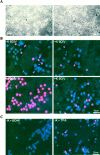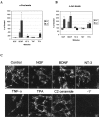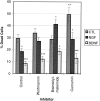Neurotrophins protect cultured cerebellar granule neurons against the early phase of cell death by a two-component mechanism - PubMed (original) (raw)
Neurotrophins protect cultured cerebellar granule neurons against the early phase of cell death by a two-component mechanism
M J Courtney et al. J Neurosci. 1997.
Abstract
Cerebellar granule neurons cultured with serum develop a mature neuronal phenotype, including stimulus-coupled release of glutamate, and depend on elevated potassium for survival. We find that cells cultured with serum undergo two phases of cell death. By 6 d in vitro, 30-50% of the cells present are dead; after this time the remaining cells die. Elevated potassium prevents only this later phase of death, whereas neurotrophins protect these cells against the early phase of death. Factors that bind p75(NTR) or TNF-R, members of the same receptor family, exhibit voltage-sensitive calcium channel-dependent protection, whereas ligands of expressed Trk receptors show additional calcium channel-independent protection. The cells express TrkB protein and show elevated c-Fos and c-Jun levels in response to BDNF. No TrkA is detected, although p75(NTR) protein is expressed and NGF induces depolarization-dependent elevation of c-Jun levels. In the presence of the protein kinase C inhibitor bisindolylmaleimide, BDNF-induced survival promotion is reduced partially, whereas NGF-induced death is unmasked. Basal survival mechanisms are insensitive to inhibition of PK-C or PI-3 kinase. We conclude that BDNF promotes survival in part via its TrkB receptor, whereas there is an additional pathway promoting survival and elevating c-Jun evoked by both NGF and BDNF via a non-Trk receptor.
Figures
Fig. 1.
Cell death occurs in two phases: L-type voltage-sensitive calcium channels prevent only the late phase. Of the cells present at 3–6 d in vitro (DIV), 30–50% were dead; the remaining cells died between 6 and 9 DIV. The early phase was not prevented by elevated KCl (+K). Elevated KCl in the absence of nifedipine prevented only the late phase of cell death.
Fig. 2.
Neurotrophic factors protect from cell death at 6 DIV. Antiserum to p75NTR ligand-binding domain prevents NGF-evoked protection. Shown is quantitation of the protective effects of the neurotrophins NGF and BDNF on cerebellar granule neuron cultures. NGF and BDNF both reduce cell death. Increasing amounts of antiserum raised against the ligand-binding domain of p75NTR prevent NGF-evoked survival promotion and reduce basal death without effect on survival in the presence of BDNF.
Fig. 3.
Neurotrophic factors, TNF, TPA, and ceramide protect from cell death at 6 DIV. A, Quantitation of the protective effects of neurotrophins, TNF, and TPA on cerebellar granule neuron cultures. NGF, BDNF, NT-3, and TNF all evoke protection against cell death. In elevated KCl (+K), 1 μ
m
nifedipine (+Nif) reduces the protective effects, and 10 n
m
TPA behaves like a neurotrophin. In low KCl (−K), nifedipine eliminates protection by NGF and TNF, but not BDNF or NT-3. Under these conditions 10 n
m
TPA is toxic. All other conditions significantly (p < 0.05) protect against cell death. B, C2 ceramide at 0.1–3.0 μ
m
protects cells cultured in elevated KCl against cell death to a similar extent to NGF and TNF. Higher concentrations do not protect against cell death. C, Spontaneous cytoplasmic-free calcium elevations exist in cells cultured in low KCl. These elevations are blocked by addition of 1 μ
m
nifedipine.
Fig. 4.
Representative fields of cerebellar granule neuron cultures in phase-contrast mode and in fluorescence mode after exposure to Hoechst 33342 and propidium iodide. A, Phase-contrast images of cerebellar granule neuron cultures at low magnification are shown. Left, Cells cultured in low KCl (−K) are shown. Right, Cells are cultured in elevated KCl (+K). B, The presence of elevated KCl (+K) in the culture medium does not alter significantly the proportion of cells with double-stained nuclei at 6 DIV (upper pair). However, by 9 DIV virtually all nuclei double stain, i.e., are dead, unless supplementary KCl is present (lower pair).C, Representative fields of cells cultured in low KCl (−K) stained at 6 DIV. Under these conditions 10 ng/ml BDNF protects from cell death, whereas 10 n
m
TPA is toxic.
Fig. 5.
Neurotrophin receptors in cerebellar granule neuron cultures. A, Cerebellar granule neurons at 1 DIV express TrkB, the selective receptor for BDNF, but not TrkA. Slight immunoreactivity to anti-TrkC at the appropriate molecular weight is detectable after prolonged exposure of film. B, Cerebellar granule neurons at 1 DIV express p75NTR, the nonselective neurotrophin receptor.
Fig. 6.
Intracellular signaling in response to neurotrophins, TNF, and TPA in cerebellar granule neuron cultures.A, Addition of BDNF, NT-3 (10 ng/ml), or TPA (10 n
m
) for 2 hr to cells 1 DIV elevates c-Fos levels (*p < 0.05); NGF or TNF (10 ng/ml) does not elevate c-Fos levels. In low KCl (−K) the BDNF-evoked elevation is reduced, and the NT-3-evoked and TPA-evoked elevations are undetectable. B, Addition of NGF, BDNF (10 ng/ml), or TPA (10 n
m
) for 2 hr elevates c-Jun levels (*p < 0.05, **p < 0.025); NT-3 or TNF (10 ng/ml) does not elevate c-Jun levels. In low KCl (−K) the BDNF-evoked elevation is reduced, and the NGF-evoked elevation is eliminated; the TPA response is maintained under these conditions. C, Immunofluorescently stained 1 DIV cells stimulated for 2 hr with neurotrophins or TNF (100 ng/ml), TPA (100 n
m
), or C2 ceramide (10 μ
m
), as indicated, were scanned with a confocal microscope. No induction of translocation of cytosolic NF-κB was detected in any condition. −1° denotes control staining omitting 1° antibody.
Fig. 7.
Effects of specific inhibitors on basal and neurotrophin-enhanced survival. Cells were cultured in the presence of elevated potassium and either no neurotrophin, NGF, or BDNF (10 ng/ml) and no inhibitor (Control), wortmannin (100 n
m
), bisindolylmaleimide (1 μ
m
), or curcumin (10 μ
m
). Neither wortmannin nor bisindolylmaleimide altered basal cell death, but in the presence of bisindolylmaleimide NGF became toxic and BDNF-evoked protection was reduced. Curcumin increased basal cell death, revealing enhanced protection by the neurotrophins. *p < 0.02 and ***p < 0.001 indicate significant difference, as compared with death with the same inhibitor and no neurotrophin; **p < 0.01 indicates significant difference, as compared with the corresponding inhibitor-free control.
Similar articles
- Signaling pathways and survival effects of BDNF and NT-3 on cultured cerebellar granule cells.
Nonomura T, Kubo T, Oka T, Shimoke K, Yamada M, Enokido Y, Hatanaka H. Nonomura T, et al. Brain Res Dev Brain Res. 1996 Nov 22;97(1):42-50. doi: 10.1016/s0165-3806(96)00130-7. Brain Res Dev Brain Res. 1996. PMID: 8946053 - Distribution of intracerebral ventricularly administered neurotrophins in rat brain and its correlation with trk receptor expression.
Yan Q, Matheson C, Sun J, Radeke MJ, Feinstein SC, Miller JA. Yan Q, et al. Exp Neurol. 1994 May;127(1):23-36. doi: 10.1006/exnr.1994.1076. Exp Neurol. 1994. PMID: 8200435 - Neurotrophins in cultured cells from periodontal tissues.
Kurihara H, Shinohara H, Yoshino H, Takeda K, Shiba H. Kurihara H, et al. J Periodontol. 2003 Jan;74(1):76-84. doi: 10.1902/jop.2003.74.1.76. J Periodontol. 2003. PMID: 12593600 Review. - Structural and functional properties of the TRK family of neurotrophin receptors.
Barbacid M. Barbacid M. Ann N Y Acad Sci. 1995 Sep 7;766:442-58. doi: 10.1111/j.1749-6632.1995.tb26693.x. Ann N Y Acad Sci. 1995. PMID: 7486690 Review.
Cited by
- From calcium to NF-kappa B signaling pathways in neurons.
Lilienbaum A, Israël A. Lilienbaum A, et al. Mol Cell Biol. 2003 Apr;23(8):2680-98. doi: 10.1128/MCB.23.8.2680-2698.2003. Mol Cell Biol. 2003. PMID: 12665571 Free PMC article. - Long-term inactivation particle for voltage-gated sodium channels.
Dover K, Solinas S, D'Angelo E, Goldfarb M. Dover K, et al. J Physiol. 2010 Oct 1;588(Pt 19):3695-711. doi: 10.1113/jphysiol.2010.192559. Epub 2010 Aug 2. J Physiol. 2010. PMID: 20679355 Free PMC article. - Cerebellar granule cells as a model to study mechanisms of neuronal apoptosis or survival in vivo and in vitro.
Contestabile A. Contestabile A. Cerebellum. 2002 Jan-Mar;1(1):41-55. doi: 10.1080/147342202753203087. Cerebellum. 2002. PMID: 12879973 Review. - Lithium blocks the c-Jun stress response and protects neurons via its action on glycogen synthase kinase 3.
Hongisto V, Smeds N, Brecht S, Herdegen T, Courtney MJ, Coffey ET. Hongisto V, et al. Mol Cell Biol. 2003 Sep;23(17):6027-36. doi: 10.1128/MCB.23.17.6027-6036.2003. Mol Cell Biol. 2003. PMID: 12917327 Free PMC article. - Brain-derived neurotrophic factor mediates the anti-apoptotic effect of NMDA in cerebellar granule neurons: signal transduction cascades and site of ethanol action.
Bhave SV, Ghoda L, Hoffman PL. Bhave SV, et al. J Neurosci. 1999 May 1;19(9):3277-86. doi: 10.1523/JNEUROSCI.19-09-03277.1999. J Neurosci. 1999. PMID: 10212287 Free PMC article.
References
- Balazs R, Gallo V, Kingsbury A. Effect of depolarization on the maturation of cerebellar granule cells in culture. Brain Res. 1988a;468:269–276. - PubMed
- Balazs R, Hack N, Jorgensen OS. Stimulation of the N-methyl-d-aspartate receptor has a trophic effect on differentiating cerebellar granule cells. Neurosci Lett. 1988b;87:80–86. - PubMed
- Balazs R, Jorgensen OS, Hack N. N-methyl-d-aspartate promotes the survival of cerebellar granule cells in culture. Neuroscience. 1988c;27:437–451. - PubMed
- Balazs R, Hack N, Jorgensen OS. Interactive effects involving different classes of excitatory amino acid receptors and the survival of cerebellar granule cells in culture. Int J Dev Neurosci. 1990;8:347–359. - PubMed
- Beg AA, Baltimore D. An essential role for NF-κB in preventing TNF-α-induced cell death. Science. 1996;274:782–784. - PubMed
Publication types
MeSH terms
Substances
LinkOut - more resources
Full Text Sources
Research Materials
Miscellaneous






